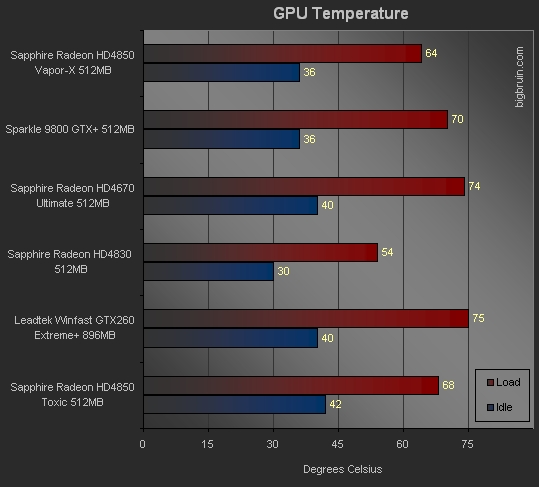Thermal Testing:
The final test was to monitor the GPU temperature by running CPUID's
HWMonitor. The idle condition was established by recording the temperature after letting the system sit at the Windows desktop for at least 30 minutes with only HWMonitor running. The load condition was established by running 3DMark Vantage two times back-to-back, followed by two back-to-back sessions of the DirectX 9 version of the Devil May Cry benchmark. HWMonitor logs current, minimum, and maximum temperature, so once all testing was completed, the maximum temperature was recorded. All testing was completed on an open testbed with relatively still air in a room with an ambient temperature of 20C.

The data above shows that the Vapor-X card runs fairly cool at all times. So, it has been documented that the card runs cool and is relatively energy efficient, but what we have not yet discussed is noise. By also producing minimal noise at all times, the
Sapphire Vapor-X Radeon HD4850 512MB graphics card scores the hat trick in terms of being 'green'. While low noise, low heat, and low power consumption would be welcome in any system, it makes this card an appealing way to add some extra muscle to an HTPC.
Overclocking:
The stock performance of the Vapor-X Radeon HD4850 512MB graphics card were what you might expect from a Radeon HD4850. Nothing that will wow a serious gamer, but more than enough to power through some of the more demanding games on reasonable settings. But, the potential for overclocking is touted in a few of the details related to the card, and of course this had to be tested.
Using the Catalyst Control Center Overdrive tab for all overclocking may limit the maximum speeds to semi-conservative values, but this may be a good thing in order to keep people from damaging their card. The maximum GPU speed allowed is 700MHz (an increase of 75MHz), and the maximum memory speed allowed is 1200MHz (an increase of 207MHz). Given the impressive GPU cooling, I was more willing to max things out on the GPU, and didn't quite want to go all the way with the memory since you can't keep an eye on the temperatures and the cooling isn't as good.
After a quick set of tests with the GPU at 675MHz and the memory left at 993MHz, I decided to max out the GPU and was pleased to see it work just fine at 700MHz. I then returned the GPU to stock speed and sent the memory up to 1100MHz. After than panned out just fine, I cranked up a bit more to 1150MHz. After a bit more testing I then raised the GPU back up so that both components were overclocked. A 12% increase on the GPU and a 15.8% increase on the memory.
Some of the tests run earlier were repeated, and here is the difference experienced...
3DMark Vantage (Performance):
» 625MHz/993MHz Total Score - 6602 Marks
» 700MHz/1150MHz Total Score - 7197 Marks
World in Conflict:
» 625MHz/993MHz Average FPS - 41 FPS
» 700MHz/1150MHz Average FPS - 46 FPS
The increases in performance are about linear with the increases in speed, and definitely make the minimal effort required worth while.